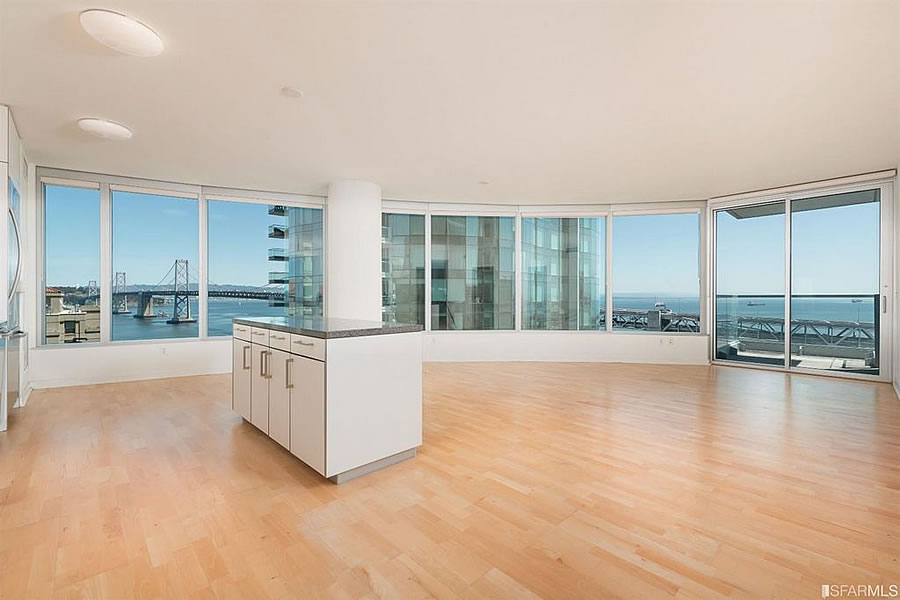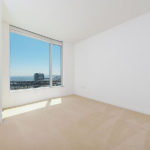Purchased for $1,550,000 in early 2008, the 1,317-square-foot unit #23D at 301 Main Street, a “signature” two-bedroom unit with Bay Bridge and water views in the first tower of the Infinity, was offered for rent at $6,500 a month in June of 2013, an effective CAP Rate (ROA) of roughly 3.4 percent when accounting for taxes and HOA dues of $900 per month.
This past March, the unit was back in the rental pool and offered at $7,000 per month, which would have represented a modest increase of 7.7 percent since 2013 or roughly 2 percent per year.
In April, the asking rent for the unit was dropped to $6,750 and then to $6,000 after another two weeks without securing a tenant at the sub-2013 rent. And two weeks after that, the vacant unit returned to the MLS listed for $1,899,500.
Reduced to $1,849,500 in June, the sale of 301 Main Street #23D has now closed escrow with a contract price of $1,795,000, a sale at which represents total appreciation of 21.4 percent for the signature two-bedroom over the past nine years, or roughly 2.1 percent per year on a straight line basis.
And if a tenant was secured at the last advertised rent, the potential CAP Rate for the unit has dropped to 2.3 percent.





I’m hopeful that there will be even more pressure on rents in the coming year. In my hood (dogpatch) there are a slew of new rental buildings opening shortly.
Shocking. Supply and demand works. Huh. Rent control only serves to keep a meaningful portion of our housing stock in horrible condition.
Are you actually suggesting that demand hasn’t kept pace with supply in San Francisco? And rather than a glib retort, any thoughts on how a feedback loop of falling rents and effective returns typically impacts the market?
Moderator, you are getting a bit glib yourself. It is not glib at all. It is well proven that with regard to housing, supply and demand dynamics are critical for setting rental rates, and artificial interventions like rent control and prop 13 have many unintended consequences that often do not benefit the community. Rent control without means testing is particularly bad policy. Further, I wish people would understand that not everyone gets to live where they want to live. People do get priced out of markets, it is a fact of life. The answer to rent is to build more, in my view, and stop putting so many conditions on developers that policy creates a disincentive.
Lastly, if you do not think that rent control creates a disincentive for LLs to invest in their properties, you have not been paying attention.
You are declaring victory when prices fall such that the rent is affordable based on the 30% of income to a household making $211K. Perhaps one of the pillars of demand is wobbling, foreign capital, profitable global tech firms or venture capital? Since demand out strips supply by several orders of magnitude, there are probably hundreds of thousands of people who would want to live in that unit at some price, it is unlikely that adding supply would see prices fall to any level approaching affordability, broadly defined.
Foreign capital buying units in anything but the highest end product is very overstated. A significant part of development cost is the price of the land. Land in SF is so expensive because of scarcity of the land and the limitation on what can be built but also because of the various surcharges that the CIty (and the voters) have attached to the land. Lower the price of the land, and you will lower the price of new units which will trickle down to all the housing stock. We have created this problem ourselves. Developers will build if we give them the tools. And before anyone makes the greedy-landlord argument, developers deserve to make a handsome profit for the risk involved in developing, They are not social service agencies.
Development cost has no bearing on sales price which is the maximum that the market will bear.
The market is comprised of demand segments, both of sources of capital and of target housing typology.
When demand flags in a segment, then price falls. Added supply has little to do with it due to the orders of magnitude differential of demand over supply.
Except that we have added more supply than normal over the last few years….and prices have dropped.
But what about the magic of “Apple & Google”?
Didn’t you previously think that their magic would be sufficient to prevent price drops due to the collapse of profitless startups, rising interest rates, the fall of the stock market from an extreme outlier CAPE ratio,…
None of that has even happened yet and now you argue that the “Apple & Google” effect has been dwarfed by a few extra condos?
How can Apple & Google prevent RE price weakness during a tech bust if they can’t even prevent price weakness in the face of a small amount of supply?
San Jose has minimal rent control, yet it saw greater rental rate appreciation than San Francisco on a percentage basis, so how does that jibe with your theory? Other surrounding areas with little to no rent control also saw comparable percentage increases. Or when you say “community” are you really talking about landlords? Because SF landlords who complain about rent control are the greediest of hypocrites, this coming from a local landlord.
Rent control is needed to maintain some semblance of social stability in cities with highly restricted supply from various factors like geography but highly liquid demand from boom and bust cycles. For example, if half of the teachers at your child’s school are forced to leave in the course of a single year that would be highly disruptive. It also makes the local economy more resilient during the inevitable downturns: for example, after the dot com bust when all the tech workers moved back to the East Coast or took a year off in SE Asia, at least there were still a few of us longer term residents around to keep the bars in business (barely).
If you want your teachers, police and firefighters to live in your community, pay them enough to live in your community.
Agreed, in a philosophical sense. However, when rents go up 50% in the course of just a couple of years, you know very well that no organization can realistically respond with any sort of pay increase that will cushion that blow. Basically if your landlord raises your rent to market, and you are single or your spouse isn’t making at least $200k per year, you’re moving out of the area. And then what happens when the market crashes again, you’ve got these SF public employees getting salaries that are double what someone is getting paid for doing the exact same job in Concord, are you going to drastically cut back their pay because rents went back down or just let the taxpayers eat it?
Except the elitists in this town, and a lot of the Bay Area in general, want teachers, police and firefighters to serve their community, but not to live in them. They think that said teachers, police and firefighters will happily commute in from Antioch or even Stockton to their jobs and can thus be paid less than wages necessary to live here. Thus preserving San Francisco as an adult Disneyland for the rich.
You must be new in town. Vast portions of SF housing stock were in horrible condition long before rent control was enacted. In some cases it was so bad that vast portions were demolished – the Western Addition comes to mind. Perhaps you should visit the Marina – it’s entirely under rent control and is far from horrible.
Um, the government demolished this housing and displaced thousands of poor people, not private investors. It was low quality housing, but cheap. And Marina apartments have enough turnover (and the market rents are so high) that the effects of rent control are not so bad.
It was “private investors” who allowed the property to deteriorate. It wasn’t low quality either – it was the same construction quality as the structures that were allowed to remain – Lower Pacific Heights Victorians.
Yes the government stepped in and demolished this housing, but not so much because the residents were “poor” but because they were Black. In the end it was largely the middle class Blacks that were displaced…the poor remained.
Dude, the Western Addition was demo’d due to Justine Herman. My grandfather owned property in the WA that was just fine. Of course Herman took his property…which is now Japan Town.
That was because people were leaving the City (1950’s to 1980’s), values were static, maintenance costs were inflating wildly….all a bad recipe for keeping housing stock in good condition. It is very arguable that, currently, rent control keeps buildings in bad condition by not rewarding improvements and limiting income. Depopulation is not our problem these days.
No. From 1940 to 1950 the population increased 22.2 percent with little to no new housing was built to accommodate this increase. The population decline from 1950 to 1980 was 13.9. As for values being static you don’t know what you are talking about – things were going through the roof in the 1970’s such that it set the stage for rent control.
Angelo Sangiacomo was the father of rent control. He raised his rents to what he felt was “market rate” and the consumers rebelled.
Yes, by the 70’s values were inflating (after a static 50/60’s which allowed things like the summer of love to happen here with hippies colonizing very cheap victorian flats in the Haight), but, remember, inflation generally was out of control in the 70’s. It’s hard to recall now how profoundly different it was. I can’t tell you off-hand (and I’m not going to do the research right now) about whether building values and building maintenance costs were vis a vis the underlying (high) inflation rate, but both Prop 13 and rent control were sold on protecting people from the costs of inflation which obviously hit people with fixed incomes (like grandma) the hardest.
To socketome, since you’re talking about historical conditions of the housing stock, it’s important to point out that the reason the Western Addition was demolished had more to do with racism than the condition of the houses. The condition of the housing stock was, to large part, a result of race-based lending policies and notorious, now illegal, redlining. Yet, in spite of it, the Western Addition was a thriving black neighborhood, and its elimination leaves S.F. culturally a much poorer place today. No way a thriving white neighborhood gets bulldozed.
Actually for a(n even) more thorough picture it should be pointed out it was, prior to WWII, a largely Japanese neighborhood (which disappeared for obvious reasons and accounts for the presence it has there now).
I’ve lived here for nearly 50 years. The housing stock largely has never looked better. Before the 80’s entire central neighborhoods looked neglected. You will always find a property owner who won’t keep up their property even in a really well kept neighborhood.
Agreed, stevenj. I’ve lived here for 31 years, and in addition to the new housing stock added (looking at you, Mission Bay and Market from 8th St all the way to Noe), a lot of the older housing stock has been renovated. Just look at the neighborhoods that were marginal then and “hot” now…Dogpatch, NoPa, Glen Park, Bernal, SoMa. Yes, prices/rents are ridiculous, and it may not suit everyone’s taste, but the overall quality of the housing stock is better now than then.
I agree too, but would also add that within the existing housing stock, the improvements are significantly more prevalent in single family, and tic/condo conversions. There remain many large multi-unit forever rent controlled properties that are less renovated. That’s not necessarily an awful thing, just an observation.
Given the really strong rents that ANY unit gets in the city, my observation is that there are building owners who do the bare minimum in investment to keep their properties safe and attractive ENOUGH to get good tenant, and do minor renovations on a unit by unit basis when they turnover, but who are not going to invest in whole building make-overs. That’s the economically rational thing to do, given the realities of rent control.
Are you suggesting that by increasing the supply of housing, we have actually affected the pricing of housing?
That’s radical talk.
That’s strange, because the supply of housing increased in 2012, 2013, 2014, 2015 and 2016 as well.
The difference today is that supply is outpacing demand. Yes, despite the fact that far fewer than the magical “5,000 units” of housing were added last year and the stock market, Facebook, Apple and Google are all near all-time highs.
And while there are over 5,000 units of housing actively under construction (along with over 13,000 units of housing for which the building permits have either been issued, approved or requested), employment in San Francisco is approaching negative growth.
But the increase in supply in 2012, 2013, 2014, 2015, and 2016 will affect the value of a home that was last purchased in 2008, no?
Who buys market rate condos for investment purposes? Only those who need a tax loss to offset gains?
The HOA fees alone would kill off any profit margins and drive down the cap rates. You are completely dependent on high income renters who can easily move to nicer and newer places each year which means there will be the two or more months of vacancy to fix up the unit find another tenant. With returns like that and limited appreciation, it is better to buy a few good value stocks with dividends.
Agreed! Bravo! Bravo! And let’s not even dig remotely into the weeds…. there is more condo product rolling off the assembly line as we speak. Why buy yours, when the developer down the street is more than willing to give you a sweetheart of a deal at his/her brand new building? Presumably if anchored to bedrock, of course…
Bedrock? Talk to the developers of the 400′ monster at the Goodwill site…ha…on an old alluvial fan!
Those who expect the cap appreciation do. And they’ve done well if they got in soon after the burst.
Agreed, Timing of the cycle is everything. If you bought in 2010 and not 2008 (ignoring the Obama first time homeowner tax credit,) you’ve done very well.
The new owner won’t get $6500 for this. $5500 maybe. $6500 perhaps if it was at the north/east corner.
Seems like a click-bating headline. Is it really any surprise rents have softened?
No surprise…I said it two years ago. Heck the pipeline was full. I also see the economy slowing into 2020 and a deep recession/depression by 2030. I do wonder if the major developments which are scheduled to start now (Goodwill site) will come on the market just as it tanks.
That’s right, we totally baited you with a headline about declining rents and returns. And when you clicked, all we delivered was a piece about…declining rents and returns with actual numbers, ratios and results! We’re totally tricky in that way…
yes 21.4% return on investment, just awful. The sky is falling!
yes 21.4% return on investment, just awful. The sky is falling!
If you’d purchased the iShares Residential Real Estate Capped ETF on January of 2008, and held it to the same month of 2017 you’d be looking at an increase of over 62%, and that’s not counting dividend reinvestment.
no hard feelings at all, don’t get me wrong, i enjoy your site and read it daily, i love real estate. SS seems generally bearish on real estate no matter the market cycle.. rarely reporting record sales and always finding ways to headline doom/gloom.. I’d love to have you on my podcast sometime. I’m local, in SF. would love to dialogue w/ you over a podcast.
Yes, a below-average return of 21.4 percent over a nine-year period, or roughly 2.1 percent per year, is fantastic. Now please wire all your funds to our investment account, we’ll guarantee you an amazing 3 percent return, that’s a whopping 50 percent more!
In terms of real records, most of which we’re the first to report before others follow our lead, try taking a peek here.
And if being data-driven without the industry cheerleading is read as “doom and gloom,” so be it.
SS; you are going off the rails a little, being snarky and sarcastic to your readers. You can disagree, without being disrespectful, IMO. This string of comments seems to really have you worked up.
[Editor’s Note: If one leads with snark or sarcasm, we have no problem following suit.]
Not sure why you seem to posture up against people in the industry. Again, no hard feelings here, I’d love an opportunity to interview and talk shop with you over my podcast which has received nearly 10k downloads with only 7 episodes so far. Real estate brokers make a lot of money in up-turns and down-turns- i have no vested interest in cheerleading a market, I just hoped your reporting was a tad more balanced, speaking as a long-time reader of your website. Would love to podcast with you.
It is rather obviously NOT a 2.1% return for the owner.
Let’s say the owner put 20% down, 300K. 1,795,000-1,550,000=245K.
So the owner put in $300K and walked away with $545K. Very roughly. Yes, there are transaction costs+HOA, but on the other side are tax savings+cost of renting. We don’t know the details, but the owner almost certainly made more than 2.1%
For such an interesting building, all of the kitchens and baths in the Infinity seem to fall a little flat.
In San Francisco residential real estate has become a commodity – to the detriment of many local residents as affordability continued to collapse during the recent boom. Many investors in condos did not care about a low or even negative cap rate – as long as they could flip the property in a few years and score a huge gain.
Not all investors eschew cap rates for short a term turnover profit. Many small time investors want a decent cap rate and are fine with just modest appreciation. Those types of investors, of which I am one, left this market to a large degree in the past 5 plus years.
Now the “appreciation” only investor is starting to pull out. They see numbers such as with this condo. They follow the national appreciation numbers. These people are no longer willing to pay ridiculous prices for condos. The corollary to that is the large institutional investor with their LLCs. As is increasingly clear, these folks are pulling out too – hence all the entitlements put up for sale. More than 800 units and perhaps as many as 1K.
The shift of RE investment dollars out of SF – from the small investor to the quick flip investor will take a significant amount of upward pressure on prices. Add in the beginnings, it seems, of a fall-off in SF’s labor force – the population is a trailing indicator and it will likely start to fall too, and there is another reduction in the upward pressure on prices.
IMO this is the start of a prolonged realignment of home prices in SF vs other metros. How long will it last – anyone’s guess, but the next 10 years are unlikely to see SF appreciation exceed to any significant degree the national average. Where this leaves major residential developments such as the Hub? I’d bet most of the proposed projects won’t get built and, by the time they are developed, what gets built will be significantly different than what is proposed now.
Yes, perhaps they’ll all be 400 foot homeless shelters.
I own a large unit in the Infinity and struggled to rent it at a rate anywhere close to a rational return against other investment classes. We’re keeping it, in part, because my wife and I love the building and location and contemplate using it as a weekend home in the future if we can afford it. But my lendingclub account is crushing the Infinity rental return against the expected selling price. It’s not a rational investment choice at the moment.
Selling prices are softening, but rental prices may even soften more. If so, it may be time to 1031 Exchange it and purchase real estate in another, more price rational market.
Deja vu all over again!
Early 2008 was the peak of the previous market, and this got 21 percent more.